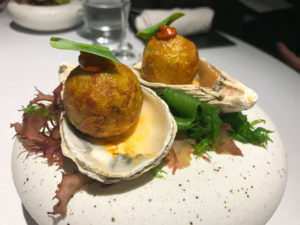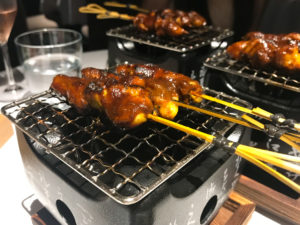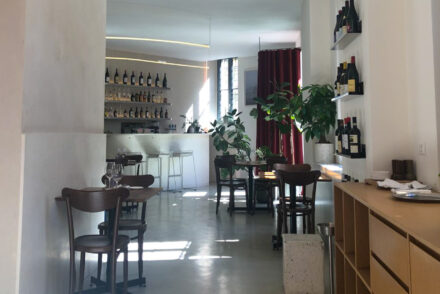Singapore is one of the greatest cities in the world for street food, favoured by the likes of A.A. Gill, Anthony Bourdain and Gordon Ramsay. Since its founding as a colonial trading port 200 years ago, Singapore has assimilated and integrated into its food scene different races and cultures. As people from all across Asia flocked to Singapore in search of a better life, they brought their spices, cooking techniques and ingredients along with them. Sometimes, they invent their own dishes here; until recently, the uniquely Singaporean Hainanese Chicken Rice could not be found on Hainan Island in China.
Hold up, you say. The same could be said about any major metropolis. Every city has its own unique food items. What makes Singapore different? Well, it is the city I call home.

Oyster balls
Apart from its world-famous hawker food, Singapore hosts a burgeoning fine dining scene as well as a local edition of the Michelin Guide. The top end of Singapore fine dining is the same as any global city, dominated by overpriced French and Japanese restaurants. Until recently, there was a 3-star Joel Robuchon Restaurant and a 2-star L’Atelier next to it, both of which closed when Robuchon himself died. Despite the prevailing opinion that posh food should be foreign and out of reach, a few chefs have tried to repackage local street food in a more elegant setting. Most of them have failed. Among the survivors is the indomitable Labyrinth, a one-Michelin-star Singaporean restaurant located in a corner of the controversially-shaped Esplanade building in Marina Bay. How this restaurant managed to survive with a dark entryway that gives off the impression that it is permanently closed is beyond me, which makes it even more impressive that it is thriving while serving unconventional high-end food in a dining room so dark it could be a dance studio.
Labyrinth is helmed by chef LG Han, a chef who took what is now becoming the traditional route to the kitchen. After quitting his job at Goldman Sachs, he travelled to Paris to learn the art of service and cooking. All this time, he experimented with different cooking techniques with the ambition of pushing the boundaries of Singaporean cuisine. With that in mind, he opened Labyrinth, serving dishes like Chili Crab Ice Cream and roast pork belly with risotto. While other Modern Singaporean or ‘Mod-Sin’ restaurants came and went, Labyrinth endured.
Chef Han’s latest tasting menu, “Homage to My Singapore,” is the latest iteration of his Mod-Sin journey and his most ambitious one yet. Apart from having to distill the essence of street food into a tasting menu, he also gave himself the challenge of using as many local ingredients as possible. This meant working with Singaporean farmers, vegetable plantations, fishermen and sauce factories – suppliers that are not known for their quality. This handicap was quickly revealed when oysters from a nearby island were served – they were neither sweet nor fat enough to be served in any decent restaurant.
The first half of the meal was unfortunately New Nordic-esque: an endless parade of simple canapés with more than just a hint of acidity. A wild-caught shrimp tempura was even served with nasturtium puree, an ingredient I was first introduced to at Noma a long time ago. The restaurant’s interpretation of rojak, a Malay salad dish, comprised individual herbs and leaves plated beautifully, reminiscent of Frantzen’s signature Satio Tempestas. After about ten of these dishes I was beginning to get properly hungry, my stomach craving for oil, fat and richness sorely missing from Labyrinth’s dishes.

Chicken, frogs’ legs and crocodile skewers
Before I could get my phone out to search for the nearest McDonalds, salvation arrived in the form of a viscous fish maw soup with savoury snapper fishcakes. From then on, my prayers seemed to be answered. Crab was served with the restaurant’s signature chili crab ice cream, masterfully showing off the chef’s understanding of temperature control and texture contrasts in a dish. A dish called “Sustainability” was a fun interlude. Three “chicken” skewers were served on a charcoal grill, but as it turns out, only one of those skewers were chicken. The other two were made with frogs’ legs and crocodile. Crocodile meat is an unwanted by-product of the local crocodile leather industry, but as it turns out, it tastes just like chicken and should be on more menus in the future.
As the thunderous booms of Singapore’s National Day Parade fireworks echoed in the background, I finished my desserts and left, satisfied and full. At around £100 for the tasting menu before drinks, it is by no means affordable. However, compared to other fine dining options in the city, this comes in at the lower end of the spectrum. The well-groomed waiters were dressed to the nines but were trained in giving distinctly un-French service, as they were cracking jokes, interacting with guests informally while still providing professional service, more than making up for the dull-black dining room.
Bound by the restrictions of using locally-sourced ingredients, this was a very good meal. Nonetheless, I could not help but feel that Labyrinth is still a work-in-progress, and the chef can elevate his cooking further without feeling the pressure to make things exquisite or delicate for the sake of it. Food can be elegant while remaining hearty, as anyone who has been to Guy Savoy can attest. Singaporean food has to be rich and oily, gooey and unctuous, and I am willing to bet that Labyrinth will be the first restaurant to put Mod-Sin cooking on the world’s culinary map.
8 Raffles Avenue
02-23
Singapore 039802
by J Khou






